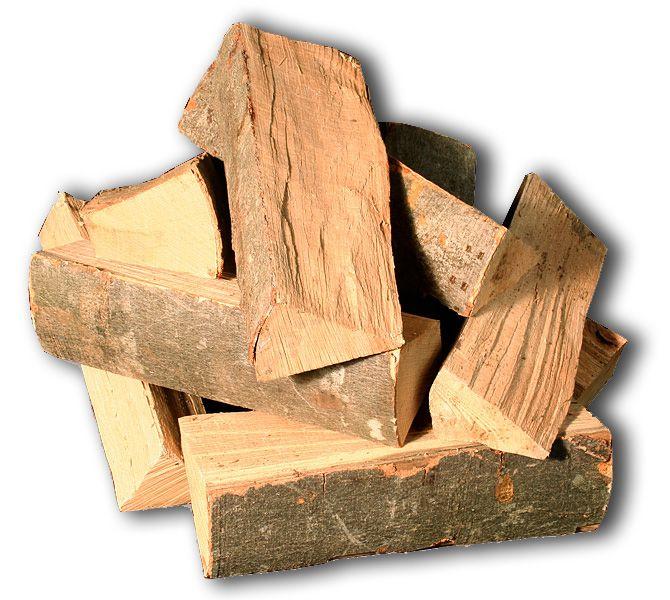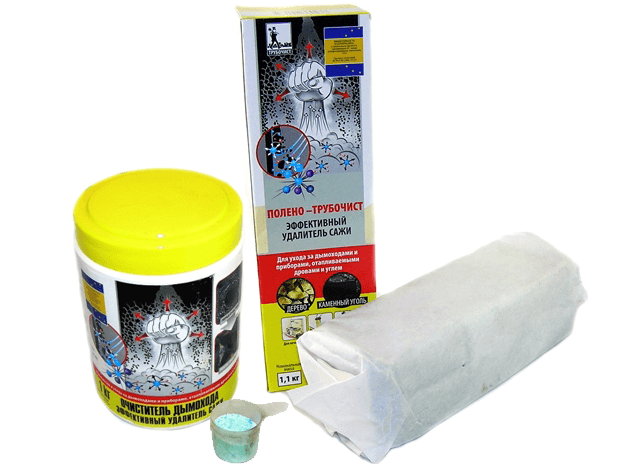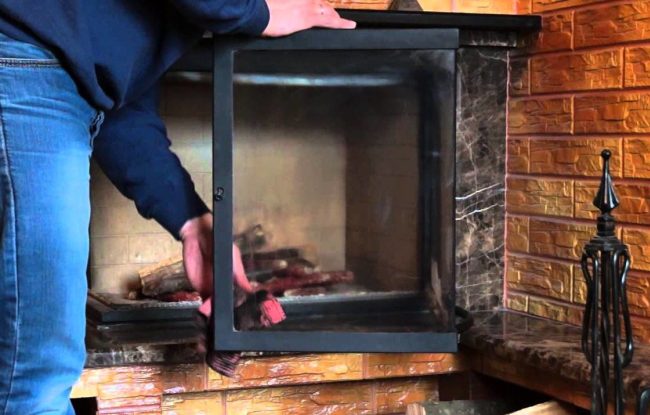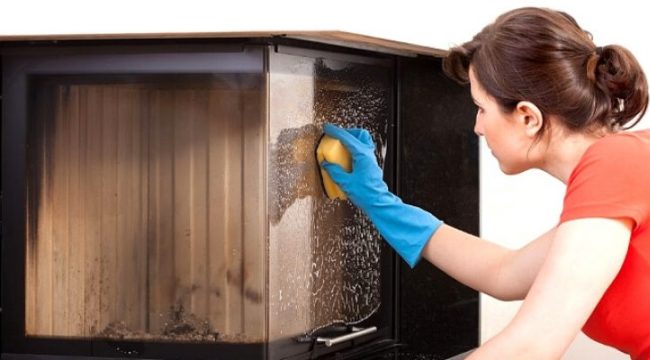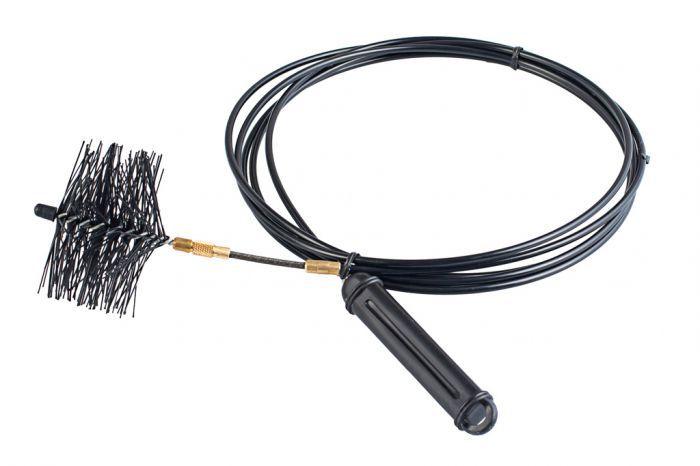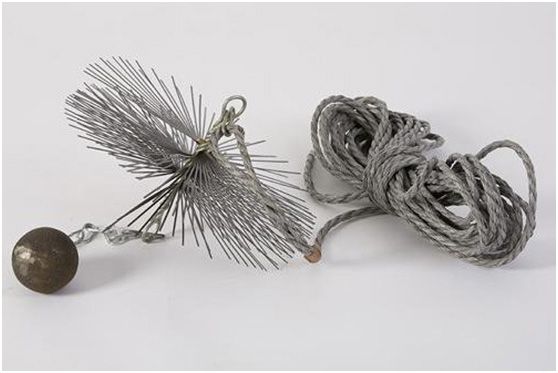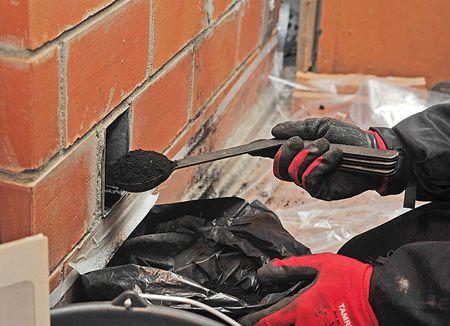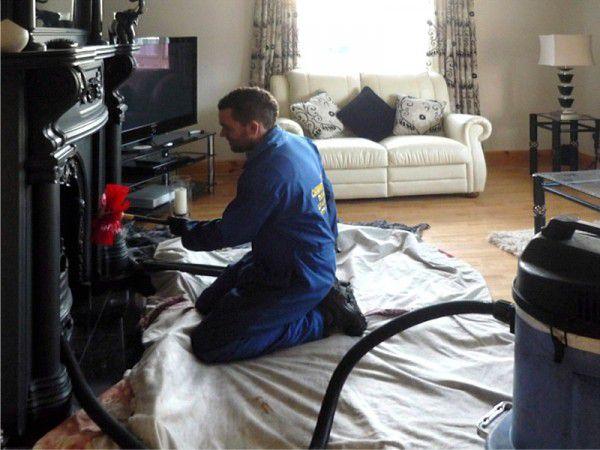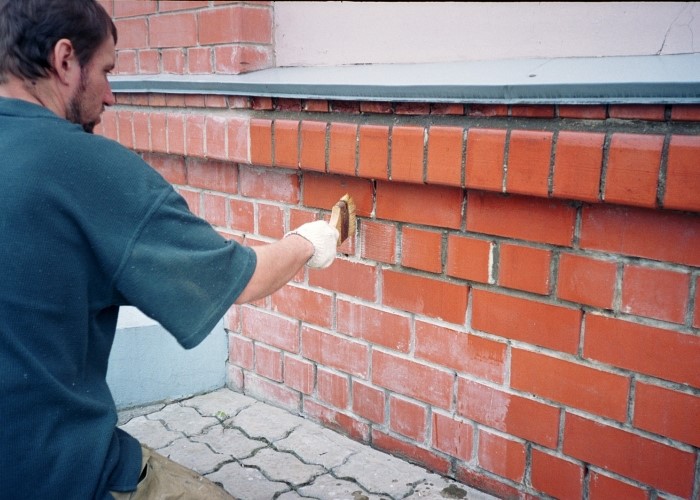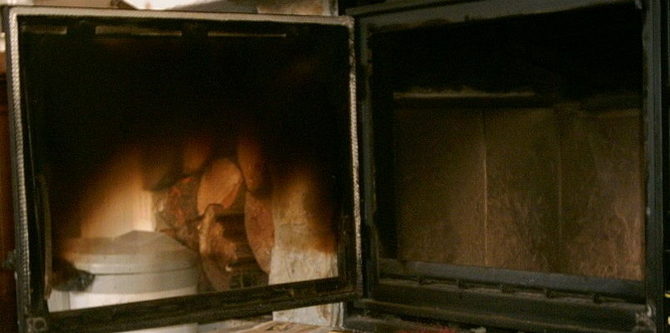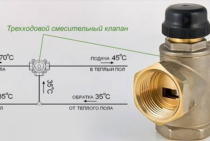mechanical tools
If the chimney clearance is very narrow or there is a large blockage, then the chemicals may be useless. In such a furnace, there is no draft, and the smoke goes inside the room. It is dangerous to use it, since deposits on pipes burn out when heated, a sheaf of sparks flies out, which can cause a fire. In this case, mechanical cleaning of pipes will help. It is produced using special tools. It can be a variety of scrapers, ruffs, brushes. To break through large and dense blockages, special cores are used. All this can be bought or made independently.

Chimneys are cleaned from top to bottom. The work is carried out in the following order:
- break through large blockages with a core;
- clean pipes with scrapers, brushes and ruffs;
- smoke channels are cleaned through the doors;
- clean the dampers, the furnace and the ash pan.
Which chimney cleaning methods to choose
Methods for cleaning chimneys and chimneys are quite diverse, from folk methods, proven for centuries, to modern ones based on scientific developments. Let's take a closer look at all of them.
Folk remedies
Our ancestors knew well the characteristics of different types of wood. Coniferous firewood contains a large amount of resins emitted along with smoke. Poorly dried, damp wood smolders, gives off little heat, and at the same time emits water vapor, which settles on the walls of the pipe, fastening loose soot into a monolith. Dry hardwood firewood is best suited for burning stoves: birch, alder, aspen. They burn with increased heat transfer, practically do not give soot and soot and do not clog the pipe.
To clean the chimney in the old days, aspen firewood was used, burning with the formation of a high hot flame. When the walls of the chimney are heated, the soot loosens and burns out, and its remnants are carried out through the chimney along with the smoke. Many modern pipe cleaning methods are based on the same principle, which are described below. For the prevention and periodic cleaning of the chimney, you can use this old method by throwing several dry aspen logs into the heated firebox. At the same time, it is necessary to observe fire safety and prevent overheating of pipes.
Another interesting folk chimney cleaning method is to burn dried potato peels. When they are burned with smoke, substances are released that loosen the soot and make it easy to remove it through the cleaning holes.
Video - a folk method for cleaning the chimney
Folk methods are interesting, but sometimes ineffective, especially when a blockage has already formed. In this case, it is more reasonable to resort to chemical cleaning of pipes.
Chemical cleaning of the chimney
Furnace stores offer a large selection of various products that allow you to clean the chimney from soot without any hassle. These products come in the form of powders, tablets, liquids or briquettes that mimic logs or pellets. Their use is quite simple: you need to put the package in a stove or fireplace and burn it, together with firewood or separately. Detailed instructions are usually indicated on the package, as is the dosage.
Powder cleaners are usually packaged in single-dose sachets, depending on the degree of contamination of the pipe and chimney, one or more bags may be needed. They are thrown into the fire after kindling the furnace, without opening. The appearance of a blue or green flame indicates that the product is working and releasing chemically active substances that break down soot and plaque.
Means for chemical chimney cleaning
Cleaning pellets or logs are more convenient to use, they are simply placed in a fireplace or stove right in the package and set on fire, after which they continue to burn the stove for one to two hours. During this time, the resins and creosote that hold the soot in the chimney decompose, and small particles are carried out with the smoke, and large blockages fall down. Therefore, after cleaning and cooling the furnace, it is recommended to inspect the smoke channel through the doors specially designed for this.
Cleaning the chimney to prevent blockages is carried out several times a year. If the oven is used no more than once a week, it is enough to use these products a couple of times a year. With the daily burning of the stove or the use of low-quality firewood, prevention is carried out more often, once every two months, without waiting for the chimney to become overgrown with soot.
Mechanical cleaning of the chimney
In case of serious blockages caused by a strong narrowing of the lumen or debris entering the pipe, chemical agents may be powerless. The operation of the stove becomes impossible and very dangerous - deposits on the walls of the chimney ignite when overheated, and together with the smoke, sparks or even flames escape from the chimney. In dry weather, this can cause a fire. If there is no draft at all in your stove, and the smoke goes inside the room, it must be cleaned mechanically, using a special tool.
Devices designed to clean the chimney from soot and soot are very diverse: these are brushes, scrapers, ruffs of various configurations and sizes, as well as cores on a strong cable that break through dense blockages. They can be purchased at specialized stores or made by hand.
Video - how to make a do-it-yourself chimney brush
Chimney cleaning is usually carried out from top to bottom: they break through blockages in the chimney, clean it with scrapers, ruffs and brushes, after which they clean the smoke channels through the cleaning doors, and lastly clean the dampers and the firebox itself, as well as the ash pan. Fireplace pipes of a simple configuration can be cleaned from below, with the help of ruffs on a long handle. How to clean the chimney mechanically is described below.
Causes of pollution
If you want to know why the glass in the fireplace is smoking, we recommend that you familiarize yourself with the following possible prerequisites:
- When using gas equipment, the appearance of deposits and soot may indicate that the burners are clogged or the jets are installed in the wrong position. All this can subsequently lead not only to the occurrence of pollution, but also to improper supply of air and gas;
- If the main component of the furnace unit is propane, various deposits and other contaminants appear on its surfaces very often and quickly. The reason for this can be either the wrong ratio of each component (air, gas) or the poor quality of the fuel. Also, the reason may lie in the fact that the regulator tank is faulty;
- The most problematic are classic wood-burning installations. Soot and soot can form if you use softwood as solid fuel. Also, the fuel itself may not burn out completely, or the reason may be hidden in the clogging of the chimney pipe. How to clean your chimney
You can take a closer look at the various types of pollution by watching the video in this article.
Is it possible to avoid soot
We will immediately answer the question in denial, because the release of combustion products is typical for any type of fuel to a certain extent, and we will talk about this degree in more detail. By using gas to operate a fireplace, many renounce the reality of a real hearth. But they compensate for this with rare device maintenance sessions. Even if glass is smoked, it is very slow compared to wood-burning models
But if the time has come quickly to clean the door, then this fact should be paid attention to.
Cleaning after use
Why does soot form at all? The fact is that the fuel does not burn completely. The more oxygen supplied to the furnace, the better the oxidation reaction takes place. The formation of soot indicates a lack of oxygen. In the case of a gas fireplace, dosing is regulated on the nozzles. One thing can be said about a wood-burning fireplace - the chimney is clogged or the ash pan has not been cleaned. Although such a procedure as cleaning the chimney, the owners of gas equipment also expect.
Different tree species, of which contain different amounts of resin. When they are burned, soot is formed that settles on the glass. Therefore, it is recommended to stock up on hardwood firewood. Before use, the logs should be dried well. Excessive moisture levels cause poor combustion and soot emission.
If you find that it is time to wash the glass of the door, then first try adding a handful of salt to the firewood. This method was often used in the past to soften the soot before cleaning the chimney. There are special fuel additives that inhibit the formation of soot. This is a kind of catalyst for the additional combustion of secondary products.
Make it a rule to remove light deposits immediately after the fireplace has gone out and cooled down. Daily cleaning is better than drastic action in case of contamination. After regular cleaning, apply a soapy solution to the glass; you do not need to wash it. The next day, after lighting the fireplace, the glass will become transparent on its own. When designing the firebox, a small gap is left at the top of the fireplace opening, through which part of the air enters the chamber. This part with its flow prevents soot from settling on the door.
13.06.2017
4427
Pechnik (Moscow)
The heating installation, which has a closed type of combustion chamber, is more whimsical to maintain. This is due to various formations, which are quite simple to eliminate, knowing what methods to apply. Fireplace glass cleaner is a great opportunity to quickly and easily remove any dirt and formations from this surface.
Cleaning the glass of the fireplace from soot must be carried out according to certain rules. This will protect and preserve the glass surface. You can learn more about cleaning methods, the compositions used and the causes of the frequent occurrence of this problem later in this article.
From grout on brick
The grout is best removed immediately from the surface of the brick. If a day has passed after application, then you can slightly moisten the contaminated places with water, wait 20 minutes, then clean with a spatula.
If much more time has passed, then you need to act according to the scheme:
- Buy a special solution in the store and dilute it according to the instructions.
- Apply to the surface.
- Wait a certain amount of time.
- Clean with a spatula.
You need to act carefully and do not overexpose the product for longer than the allotted time. Before starting work, it is best to glue the seams with a thin masking tape so that a chemical agent does not get into them.
Choosing a means for cleaning the glass of the fireplace from soot
An important role in the qualitative destruction of traces of dirt is played by the type of fireplace. Simply put, in order to wash gas and, for example, propane from soot and deposits, it is necessary in a different way. Gas, unlike other types of fuel, emits the smallest amount of combustion products. Thanks to this, it is necessary to take up a rag much less often. At the same time, it is necessary to make a reservation that we are talking about high-class gas.
The appearance of even slight traces of soot indicates the need for immediate maintenance. Most likely, there was a depressurization of the chamber.
Before buying this or that means for cleaning the glass of a fireplace from soot, you should read reviews about it on the Internet.
If we are talking about a propane or wood version, then the procedure is as follows:
- First you need to choose a tool that allows you to remove the sticky coating that constantly forms in the oven;
- You can use a paste or spray that softens deposits;
- After that, you need to take a hard sponge and wipe the surface.
Gas fireplaces require little to no cleaning if properly maintained. If traces of burning still appear, then this indicates a malfunction of the furnace. The situation is more complicated with propane fireplaces or their wood-burning counterparts. First, the sticky coating is softened, and only then traces of soot are removed with a sponge.
Simple means than to clean the glass of the fireplace from soot video
No matter how much you would like it, it is impossible to quickly clean the fireplace glass, although some manufacturers are trying to convince you of the opposite. Cleaning and detergent is selected according to the type of fuel used. The easiest way to deal with dirt is in a gas fireplace, and more difficult in its wood or propane counterpart. Regular preventive inspections will help to reduce the duration of cleaning.
Prevent clutter.
After the last kindling of the fire, wait at least until the next morning. Put on some old clothes and a pair of gloves as you will be touching a rather toxic substance. Sturdy leather gloves are good, but it's still better to give preference to rubber household gloves.
- Take some newspapers and lay them on the floor in the fireplace, positioning them so that they rise up the walls of the fireplace a few centimeters. Soot will fall on these newspapers, which you will remove.
- Protect your carpets and floors by covering them with cheap plastic sheeting. Also bring a large trash can covered with at least two plastic bags.
Hold your hand over the ashes to check for residual heat.
If the fire was strong, feel the ashes with a poker or fireplace shovel. Remove the grate or iron wood stand in the fireplace and take it outside where you can clean it later. Slowly shovel the ashes into a metal bucket or use a vacuum cleaner.
Examine the chimney.
Take a flashlight, get on your knees and look around the chimney all the way to the vent, which usually looks like a small metal door at the very top of the chimney. This hole is most likely controlled by a metal lever. Hit it and if the door moves, you'll know you're looking at an air vent. This hole should remain open until you have cleaned everything. You will almost certainly see soot, a brown or black powdery residue. It's pretty easy to remove. If the light from the flashlight hits a dry substance that cracks to the touch, has flaky layers and a shiny, hardened black residue, then you have creosote and it's time to get rid of it.
Start scraping.
The best brush for removing creosote and soot is a round metal chimney brush. Remember what Duke van Dyck carried when he was a chimney sweep at Merry Poppins? These brushes look almost the same, and will vary from 20 to 25 centimeters in diameter. You will need to buy a brush that is 2.5 centimeters larger than the vent. You will also need to buy one or two flexible poles so that you can push the brush the entire length of the chimney and clean it completely.
Brushes and poles can be purchased at most hardware stores.
Clean thoroughly.
Use a wire brush to clean your BBQ grill or a strong nylon brush.
- Take a plastic bucket, fill it with 3.8 liters of water and add six tablespoons of sodium orthophosphate or its substitute, as well as a glass of chlorine bleach. If you are concerned about the caustic nature of these substances, you can use baking soda or vinegar instead.
- Start brushing as high as you can and then work your way down. You may be worried about how much dirt there is, but it will soon make up for it by how happy you will be when your fireplace walls are completely clean.
Clean and rinse.
Carefully pick up the newspapers, the soot on which is now unable to harm you, and throw them into the trash can left nearby.
- Take a sponge, rag or paper towels and clean the walls of the chimney and the floor of the fireplace with clean water.
- Gradually gather up the plastic wrap and discard it as well.
- While the firebox is drying, go outside and use a wire brush to remove the soot from the metal firewood stand and metal grate.
- If the stand is made of copper and you want to show it off, put some metal polish on it.
- Put everything back in place, close the vent and your fireplace will be ready to start a safe fire again.
The safety of residents and the safety of property depend on the health of the heating system at home, therefore preventive inspections of chimneys are necessary at least twice a year
It is especially important to carry out a design revision if the chimney has not been used for a long time, because. small branches, sand, debris can accumulate in the smoke channels
Fireplace chimneys are cleaned as needed. To make such a need as rare as possible, it is important to follow the rules for operating fireplaces and use dry firewood with a minimum resin content.
We remove dirt with folk remedies
The most unpleasant consequence of fuel combustion is a dense layer on the glass, representing soot and soot. Due to the fact that the basis of this coating is creosote, which, like a magnet, attracts particles of soot to itself, a simple treatment with a damp cloth will not help here. We have to resort to the accumulated experience, because we have always faced similar problems.
- If the glass has been smoked recently, and the soot layer has not had time to dry in the creosote, then it is quite possible to use self-cleaning, which consists in burning dry hardwood firewood with plenty of air. To do this, you need to fully open the blower door. At high temperatures, the soot particles burn out, and the glass is freed from soot. But this method is good only if you find out in time that glass cleaning is required.
- Water and vinegar are mixed in equal parts. The resulting solution is poured into a spray bottle. will have to be dismantled and put on a horizontal surface. A layer of newspapers is superimposed on the smoked areas. With acetic solution, these newspapers are impregnated and aged for some time. Then, with wet newspapers, as a matter, glass should be processed.
Be sure to wear rubber gloves while working.
Sometimes ash taken from the ash pan is used to clean the glass. It is known to form an acidic environment. Under the action of chemical reactions, the soot is split and the surface can be washed. For ease of use, use a sponge. The ash must not contain dirt, otherwise the glass can be scratched. Ashes are poured onto a moistened sponge and with gentle movements they begin to process the surface. If necessary, the sponge should be washed well and a new portion of ash should be added again.
Another recipe for making a glass fireplace door soot remover is based on mixing ammonia, vinegar, lemon and baking soda. First, a layer of soot must be moistened, after which we clean the soot with ease
It is important to remember that an increased concentration of ammonia will make it possible to make a more active solution, and glass cleaning will be simplified, but the ammonia will quickly evaporate, and this fact will have to be taken into account.
Chimney cleaning technology
1. Before taking on the role of a chimney sweep, take care of your own safety.It is necessary to install a convenient ladder on the roof and take care of insurance that will not allow you to fall. When cleaning the chimney, use a respirator.
Work Safety Measures
2. The dampers are open, otherwise soot will accumulate on them, which can lead to even more clogging. But the doors - furnace, ash and cleaning - must be tightly closed so as not to stain furniture and floors with soot. It is better to hang open fireplace inserts with a damp cloth, which is not a pity to throw away - most likely it will not work to wash it off.
3. Cleaning starts from the top, from the chimney. Before cleaning, remove the head from the pipe, remove soot with a scraper or a stiff brush at an accessible distance. The tool can be extended with an extendable handle.

Cleaning starts with a pipe
4. Inaccessible parts of the chimney are cleaned using a flexible brush - a cable with a nozzle at one end and a handle for rotation at the other. The diameter of the nozzle should exceed the diameter of the pipe by 1.2-1.3 times. The cable is inserted into the chimney and begin to gently advance by turning the handle.
Flexible brush for cleaning pipes from soot
5. If the ruff gets stuck, it means that a serious blockage has formed in the chimney, and it can only be broken through with the help of a core. The core on the cable is sharply lowered into the chimney, trying not to touch the walls so as not to chip the brick. Having eliminated the blockage, continue cleaning with a ruff.
Pipe cleaning core
6. After cleaning the pipes, they begin to remove soot through the cleaning doors. In a complex furnace, as a rule, there are several of them, and they are located in the places where the smoke channel turns. First, the soot that has fallen from above is raked out, then the smoke channel itself is cleaned with scrapers and a ruff. At the same time, they move from top to bottom, to the firebox. In fireplaces with a direct chimney, there may not be any cleaning doors at all, and all the soot immediately falls into the furnace.
Cleaning of smoke channels from soot
7. The furnace and ash pan are cleaned last. Final cleaning can be done with a vacuum cleaner. If your vacuum cleaner is equipped with a fabric dust bag, it is better to buy a disposable paper bag for this purpose, since it is impossible to clean it of soot.
Removing soot from the furnace with a vacuum cleaner
8. Melt the stove and check the draft. If cleaning has eliminated the blockage, then after the furnace has cooled down, the head is put back on. If the draft has not improved, the smoke channel in a hard-to-reach place may be clogged, and you can no longer do without the help of a qualified stove-maker.
9. In the future, when using the stove, do not neglect the prevention of blockages using the folk or modern methods described above.
To prevent the chimney from overgrowing with soot, you must follow a few simple rules:
- It is better to use dry firewood from deciduous trees as fuel, and at the end of the firebox, periodically place aspen or preventive measures in the furnace.
- Do not burn garbage in the oven, especially plastic, polyethylene, wrapping paper.
- To reduce moisture condensation, the chimney must be insulated, especially if it is made of metal. Usually, ready-made double sandwich pipes with a layer of non-combustible insulation are used.
- It is imperative to put a cap on the pipe to protect it from accidental ingress of debris or precipitation.
With proper use of the stove, the question "how to clean the chimney from soot" will arise very rarely, and you will be able to fully enjoy the bright flame and heat.
After a certain time of flawless operation of any fireplace or stove, these devices begin to cause certain inconveniences. , firewood at the beginning of kindling constantly goes out, and the smoke from the firebox does not rise up, but tends to get into the room. An experienced fireplace owner will immediately note that it is time to clean the device.
Do not forget that there is a real fire in the fireplace
First you need to decide why you need to clean fireplaces.Theoretically, the combustion products of wood are carbon dioxide and water in the form of steam, which escape through the chimney. However, in this composition there is also a small proportion of solid fractions, which are formed during the combustion of the resins that make up the wood. These fractions form soot, which, under the action of water vapor, acquires a dense consistency and settles on the walls of the chimney pipes.
The most polluted areas are brick pipes with a rectangular channel, junctions of metal pipes, pipe narrowing. But the need to clean the chimney can lead to debris that has fallen into it from the outside. It can be fallen leaves, a flown bird, a web.
From white plaque
The white coating that appears on the brickwork is formed due to the penetration of the salts contained in the solution to the surface. Often this problem occurs after heavy rainfall and brings a lot of problems.
Salt negatively affects not only the appearance of the walls, but also the strength of the material. It destroys the top layer of the brick, which leads to the formation of cracks and chips. Therefore, it is necessary to get rid of this problem in time.
You must purchase a special cleaner concentrate at a hardware store. After that, dilute with water in a ratio of 1:10. Then:
- Apply the mortar to the wall with a brush.
- Leave for 20 minutes.
- Wash off with water. You can use a clean cloth for this.
The acids and various surfactants found in whitescale removers react with salts, making them easy to remove. To consolidate the result, the surface of the walls must be covered with water-repellent agents so that by the next year you do not have to remove plaque again.
Fireplace glass cleaning
How to clean fireplace glass? The first question that arises before users. And this is not surprising, because closed-type fireplaces need to be cleaned much more often than open fireplaces. Cleaning procedures should be carried out regularly, because the slightest dirt will be immediately noticeable on the screen for a glass fireplace.
First you need to figure out: why is glass smoked in the fireplace?
The reason for the formation of pollution on the glass of the fireplace insert can be several:
- If the fireplace operates on gas fuel, then soot and soot indicate that the burners are clogged or jets
stand incorrectly. All these shortcomings affect the fact that air and gas are correlated incorrectly and, as a result, soot settles on the inner walls of the furnace. - Units operating on propane are even more prone to the formation of dirt than gas fires. And most often the main reason lies in low-quality fuel, clogged burners and damage to the regulator tank.
- Fireplaces fueled by wood. Soot is most often formed on the glass of such devices. This is usually due to the fact that coniferous trees are used as fuel. Another reason is the lack of air holes.
- Also, soot can occur as a result of contamination in the exhaust pipe.
Soot on the fireplace glass
To cope with the problem, you need to know how to clean the glass of the fireplace.
Fireplace glass cleaner is a great solution to this unpleasant situation. Today, a large number of various chemicals are sold that will successfully cope with deposits of soot and soot.
When choosing a cleaning agent, look at the composition: it should not contain any aggressive components that can damage the glass.
What else can be used to clean smoked fireplace glass besides special chemical compounds? You can use regular dishwashing detergent, but this will take some effort.
Another great remedy is ammonia, which allows you to clean soot well.
The steps for cleaning glass with ammonia are as follows:
it is necessary to wait until the fireplace has cooled down, it is important that the door is cold;
then in a container you need to mix ammonia and water, add a small amount of vinegar to the mixture. The resulting composition must be filled with a spray bottle;
then just spray the liquid on the glass and wipe it with paper towels .. There are other methods for cleaning glass from soot:
There are other methods for cleaning glass from soot:
- The fire is lit at full power until the flame burns the soot that has settled on the glass. This technology not only effectively removes contaminants, but also allows you to maintain cleanliness in the chimney.
- The next method is that the newspaper is lowered into the water, and then into the ashes at the bottom of the firebox. Then you need to apply it to the contaminated area and rub until you remove the plaque. After finishing the cleaning process, wipe the glass with a dry cloth. It is worth noting that such a process is quite laborious and time-consuming, but effective.
Follow a number of simple rules and you will have to clean the glass fireplace doors much less often:
- Every time after the fireplace stops working, it is necessary to wipe the door. In this way, you can avoid long-term routine glass cleaning when soot accumulates.
- To make the glasses as transparent as possible, wash them with ordinary soap. After each cleaning, apply soap to the glass. As soon as the fireplace heats up, all soap stains will dissolve and the glass will become transparent.
- In order to bring the glass to the formation of strong soot, fireplaces should only be fired with clean and dry wood.
- When using the fireplace, use the “clean glass” method. It is based on the fact that a narrow gap must be made on top of the glass. When air penetrates through it, an invisible barrier will form that will prevent the appearance of plaque. On sale there is a door with similar openings.
Knowing how to clean the glass of the fireplace from soot, you can get rid of dirt at any time.
Therefore, there is nothing complicated in cleaning the fireplace.
Purification technology
When carrying out work, safety rules must be observed. A ladder is installed on the roof and an insurance is attached that does not allow a person to fall. Use a respirator while cleaning. Do-it-yourself chimney cleaning is carried out as follows:
- Open the stove damper to prevent soot from accumulating, as this can increase the gap. The furnace ash and cleaning doors are closed so that soot does not fall on surrounding objects. The fireplace insert is covered with a damp piece of cloth.
- They remove the head from the chimney and remove the soot with a scraper or a ruff on a long handle.
- Places that cannot be reached with a scraper are cleaned with a ruff on a flexible cable. It is launched into the chimney and gently moved forward.
- If a dense blockage interferes with the movement of the ruff, then it is pierced with a core. Do this carefully so as not to chip the lining of the inside of the chimney.
- After cleaning the pipes, soot is removed through the cleaning doors. The smoke channel is cleaned with a scraper. If the fireplace is equipped with a direct chimney, then there are no cleaning doors. In this case, the soot is removed directly from the furnace.
- At the end of the work, the ash pan and the firebox are cleaned. For this purpose, it is convenient to use a vacuum cleaner with a disposable paper bag.
- To check the draft, he melts the stove. If it has not recovered, then the blockage has not been eliminated. It can be located in a hard-to-reach place, and a specialist should be called to remove it.
To facilitate the work of removing blockages, it is necessary to carry out preventive cleaning in a timely manner using chemicals or folk methods.
To avoid clogging the chimney, observe the following precautions:
- Do not burn plastic bags, plastic wrap, wrapping paper and other garbage in the oven.
- Dried wood of coniferous trees is used as fuel.At the end of the furnace, for prevention, aspen firewood or chemicals for cleaning pipes are placed in the furnace.
- To prevent the appearance of condensation and moisture on the walls of the chimney, metal chimneys are insulated. Usually, ready-made pipes with a layer of insulation are used for this.
- To prevent debris from entering the chimney, a cap is put on it.
To prevent deterioration of draft in chimneys, they should be cleaned regularly. Cleaning is done by folk methods, chemicals or using tools. Large blockages in the furnace are punched with special cores on cables, and then the smoke channels are cleaned with scrapers.
If the glass door of a fireplace or wood-burning stove is heavily soiled and darkened by a thick layer of soot, it will take a long time to clean, rub and polish. It is much easier to clean the door if you do it regularly and make sure that the glass does not get dirty. In addition, to reduce the need to clean the glass door of the fireplace, you can use cleaner fuels that produce less smoke and soot.
